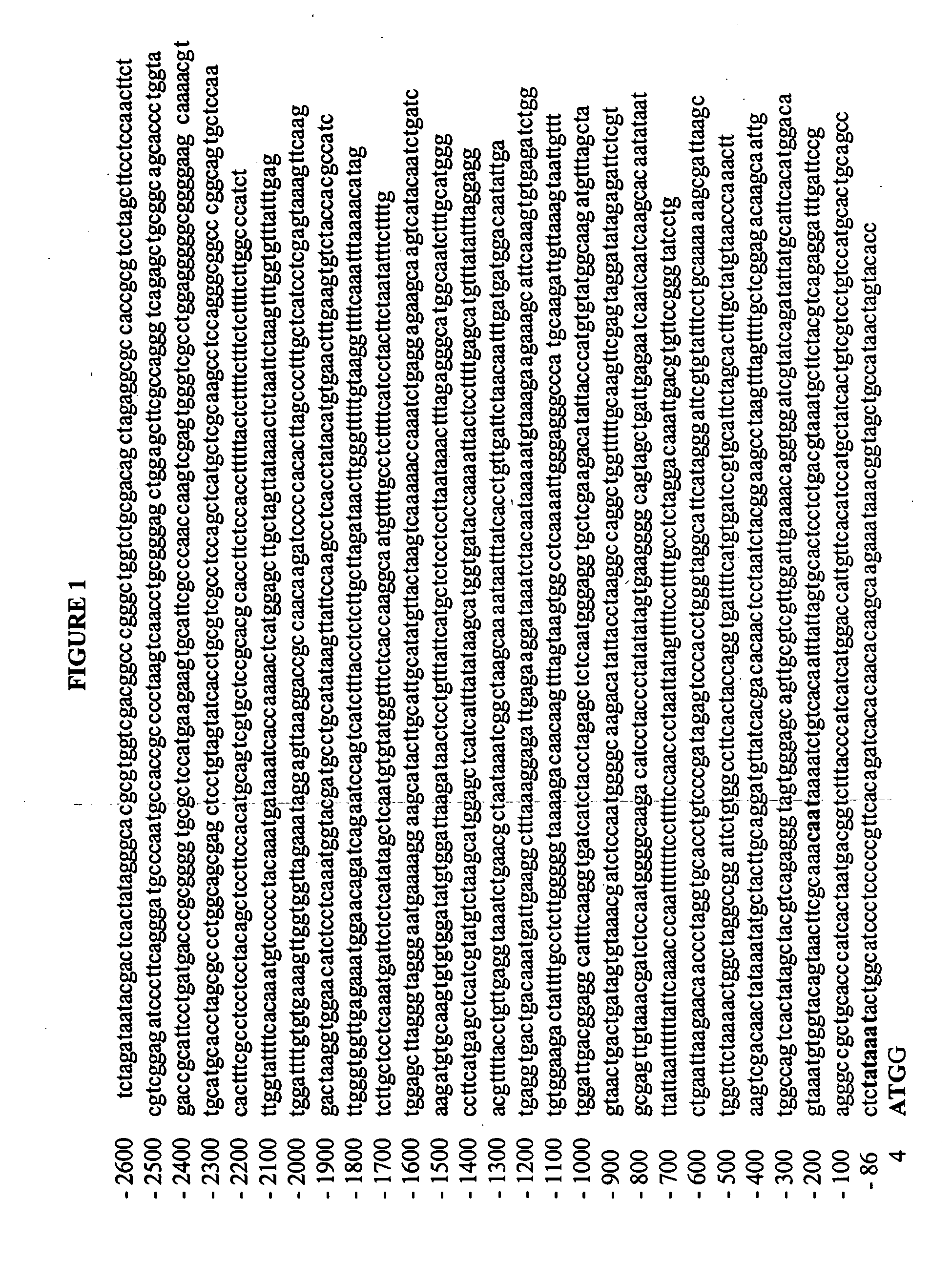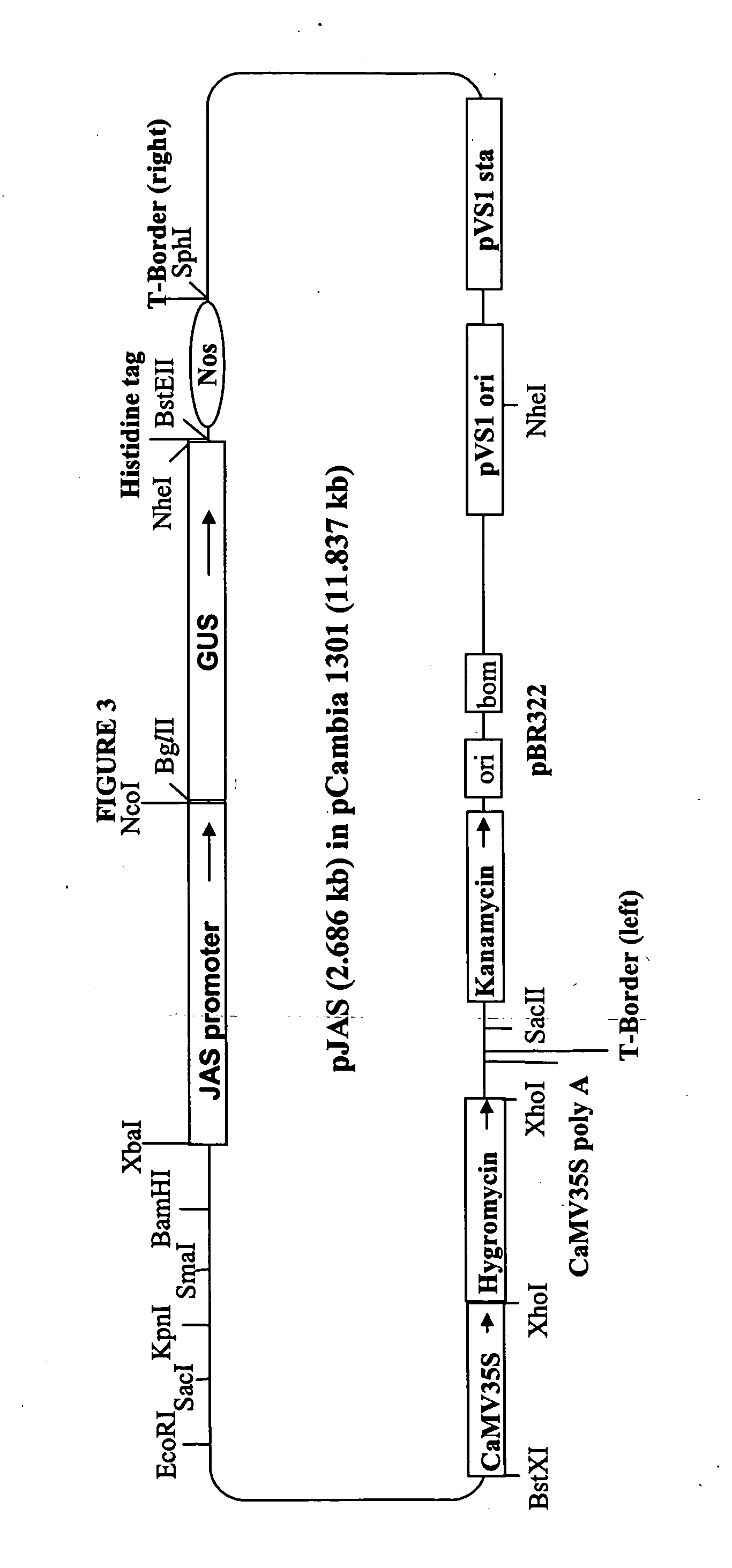Stem-regulated, plant defense promoter and uses thereof in tissue-specific expression in monocots
a monocot and promoter technology, applied in the field of plant functional genomics, molecular biology and genetic engineering, can solve the problems of low research in developing sugarcane specific technologies such as genes and promoters that are functional in sugarcane, no public-domain sugarcane promoters available for use in sugarcane transformation, and requirements for high-level constitutive production of proteins
- Summary
- Abstract
- Description
- Claims
- Application Information
AI Technical Summary
Benefits of technology
Problems solved by technology
Method used
Image
Examples
example 1
Identification of Stem-Specific cDNAs
Stem-Specific cDNA Macroarray Analysis
[0077] To identify cDNAs that were expressed in sugarcane stems, a cDNA library representing stem mRNA was constructed and screened by differential hybridization.
[0078] In order to have a cDNA library that has a good representation of mRNA from all regions of the stem, mRNA was separately isolated from top, mid and bottom portions of the stem of Saccharum spp. cultivar CP72-1210 and a pooled sample was used for preparation of the cDNA. Total RNAs and poly(A)+ RNAs were prepared using the RNeasy kit and Oligotex kit from Qiagen, respectively. For the synthesis of cDNAs, the SMART PCR cDNA library construction kit (BDBiosciences Clontech) was selected since this technology utilizes a unique SMART oligonucleotide (cap finder) in the first strand cDNA synthesis followed by a long distance PCR (LD PCR) amplification to generate high yields of full-length ds cDNAs. A pooled sample consisting of 100 ng of each o...
example 2
Effects of Defense-Inducing Agents on OMT Upregulation
[0088] The 251 cDNA clones used for microarray analysis in Example 1 were further used to assess the effects of defense-inducing agents on the expression of the stem-specific genes.
[0089] Total RNA was extracted from wild type sugarcane plants (3 months-old) that were sprayed with the defense-inducing agents jasmonic acid (JA) (25·mu·M in 0.05.percent.Tween 20), methyl-jasmonate (MeJA) (200·mu·M in 0.1.percent.ethanol and 0.05.percent.Tween 20) or salicylic acid (SA) (5 mM in 0.05.percent.Tween 20) for two time periods, 24 and 48 hours. The microarray including 251 cDNAs was probed with fluorescently labeled cDNAs synthesized from 1·mu·g of total amplified RNA. One cDNA probe (e.g. RNA from plant treated with a defense-inducing agent) is labeled with one dye (Cy5), and the second (e.g. RNA from untreated control plant) with another dye (Cy3)
[0090] Microarray data was analyzed using GeneSpring analysis software. Data were norma...
example 3
Isolation and Cloning of Genomic Sequence Corresponding to JAS Gene and Promoter Release
[0092] Initially, an attempt was made to use PCR walking to clone the JAS promoter directly from genomic DNA. However, the complexity of the sugarcane genome and the presence of substantial amounts of repetitive DNA in it rendered this approach unworkable.
[0093] A second attempt to locate the JAS promoter was made using a sugarcane bacteriophage lambda (BAC) genomic library. BAC library filters were probed using a full-length JAS cDNA probe. Three screening were performed to select genomic clones exhibiting strong hybridization to JAS cDNA. Phage DNA was isolated from 13 candidate JAS genomic clones and digested with restriction endonucleases (EcoRI and HindIII) prior to DNA gel blot analysis. DNA gel blot analysis (shown in FIG. 9) revealed common restriction fragments containing the JAS gene. This indicated that the 13 JAS clones were most likely representative of a single JAS locus.
[0094] H...
PUM
| Property | Measurement | Unit |
|---|---|---|
| time | aaaaa | aaaaa |
| time | aaaaa | aaaaa |
| herbicide resistance | aaaaa | aaaaa |
Abstract
Description
Claims
Application Information
 Login to View More
Login to View More - R&D
- Intellectual Property
- Life Sciences
- Materials
- Tech Scout
- Unparalleled Data Quality
- Higher Quality Content
- 60% Fewer Hallucinations
Browse by: Latest US Patents, China's latest patents, Technical Efficacy Thesaurus, Application Domain, Technology Topic, Popular Technical Reports.
© 2025 PatSnap. All rights reserved.Legal|Privacy policy|Modern Slavery Act Transparency Statement|Sitemap|About US| Contact US: help@patsnap.com



